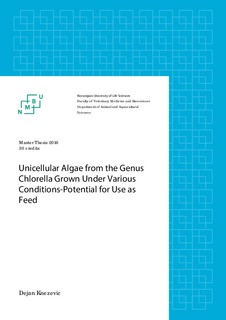Unicellular algae from the genus chlorella grown under various conditions : potential for use as feed
| dc.contributor.advisor | Storebakken, Trond | |
| dc.contributor.author | Knezevic, Dejan | |
| dc.coverage.spatial | Norway | nb_NO |
| dc.date.accessioned | 2016-08-18T12:18:54Z | |
| dc.date.available | 2016-08-18T12:18:54Z | |
| dc.date.issued | 2016-08-18 | |
| dc.identifier.uri | http://hdl.handle.net/11250/2399852 | |
| dc.description.abstract | Diverse morphological and physiological characteristics of microalgae are enabling their use in the production of protein, vitamins, antioxidants, drugs, immunostimulants, biofuels and food supplements. These physiological characteristic was the main reason for intensive research on microalgae cells in recent years. Being singe celled gives them the opportunity to spread on the much wider surface maximizing use of sunlight contrary to plants that has limited surface and position. Their simple cell structure will ensure the rapid and successful growth of under various conditions. This characteristic enables them to be present in the most diverse ecosystems (sea, rivers, lakes, lagoons) and the habitats with unfavorable environmental conditions for other species. Algae can grow in places that are unsuited for agriculture, such as desert, wastelands or unfertile coastal areas | nb_NO |
| dc.language.iso | eng | nb_NO |
| dc.publisher | Norwegian University of Life Sciences, Ås | |
| dc.subject | Chlorella | nb_NO |
| dc.subject | Effluent waters | nb_NO |
| dc.subject | Cultivation methods | nb_NO |
| dc.subject | Animal Feed | nb_NO |
| dc.title | Unicellular algae from the genus chlorella grown under various conditions : potential for use as feed | nb_NO |
| dc.type | Master thesis | nb_NO |
| dc.subject.nsi | VDP::Agriculture and fishery disciplines: 900 | nb_NO |
| dc.source.pagenumber | 42 | nb_NO |
| dc.description.localcode | M-HV | nb_NO |
Tilhørende fil(er)
Denne innførselen finnes i følgende samling(er)
-
Master's theses (IHA) [318]
